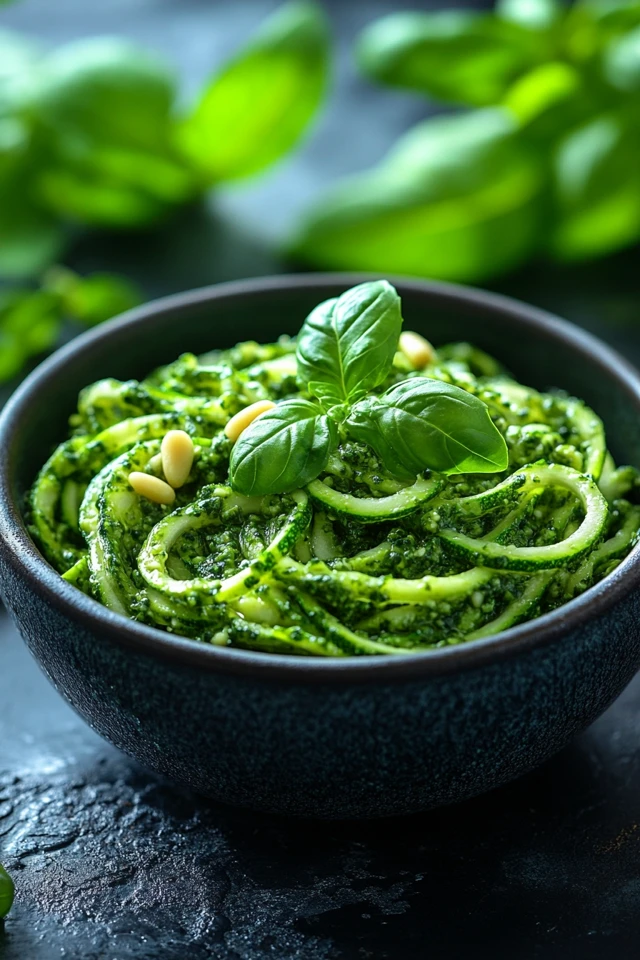Introduction
In the quest for healthier and more sustainable meal options, Zucchini Noodles with Pesto: Light & Herbaceous emerge as a stellar choice. Combining the freshness of zucchini noodles with the vibrant flavors of homemade pesto, this dish offers a delightful balance of taste and nutrition. Perfect for those seeking a low-carb, gluten-free, and plant-based alternative to traditional pasta, these zucchini noodles—often referred to as “zoodles”—provide a versatile canvas for culinary creativity.
Whether you’re preparing a quick weeknight dinner, a satisfying lunch, or an impressive dish for guests, zucchini noodles with pesto deliver both visual appeal and hearty satisfaction. In this comprehensive guide, we’ll explore the benefits of this light and herbaceous dish, provide a detailed recipe, and share tips and variations to customize your meal to perfection. Let’s embark on a flavorful journey to create a dish that’s as nourishing as it is delicious!
Why Choose Zucchini Noodles with Pesto?
Opting for Zucchini Noodles with Pesto offers a multitude of benefits that cater to both your health and culinary preferences. Here’s why this dish should be a staple in your meal planning:
Nutritionally Superior
- Low-Carb Alternative: Zucchini noodles are an excellent substitute for traditional pasta, significantly reducing carbohydrate intake without sacrificing texture or flavor.
- Rich in Vitamins: Zucchini is packed with vitamins A and C, potassium, and antioxidants that support immune function and skin health.
- Healthy Fats: Homemade pesto made with nuts and olive oil provides heart-healthy monounsaturated and polyunsaturated fats essential for overall well-being.
- Fiber-Rich: Both zucchini and the ingredients in pesto contribute to a high fiber content, promoting digestive health and sustained energy levels.
Versatile and Customizable
- Flavor Adjustments: Easily tweak the pesto by adding different herbs or spices to suit your taste preferences, whether you prefer a more robust or milder flavor.
- Ingredient Flexibility: Incorporate additional vegetables, proteins, or grains to enhance the nutritional profile and make the dish more filling.
- Seasonal Adaptations: Use seasonal herbs and vegetables to keep the dish fresh and exciting throughout the year.
Easy to Prepare
- Quick Prep Time: With minimal ingredients and straightforward steps, zucchini noodles with pesto can be prepared in under 30 minutes, making them ideal for busy schedules.
- Meal Prep Friendly: Prepare the pesto and spiralize the zucchini in advance to assemble the dish quickly during the week.
Ethical and Sustainable
- Plant-Based: Embracing a plant-based diet reduces your carbon footprint and supports sustainable eating practices, benefiting both your health and the environment.
- Gluten-Free: This dish is naturally gluten-free, catering to those with gluten sensitivities or celiac disease without compromising on taste.
Ingredients
Creating Zucchini Noodles with Pesto involves a harmonious blend of fresh zucchini, aromatic herbs, and nutritious ingredients. Here’s what you’ll need:
For the Zucchini Noodles
- Zucchini: 4 medium-sized, spiralized into noodles (zoodles)
- Olive Oil: 1 tablespoon (for sautéing)
- Salt: To taste
- Black Pepper: To taste
For the Pesto
- Fresh Basil Leaves: 2 cups, packed
- Pine Nuts or Walnuts: 1/4 cup (toasted for enhanced flavor)
- Garlic: 2 cloves
- Nutritional Yeast: 3 tablespoons (optional, for a cheesy flavor)
- Lemon Juice: 2 tablespoons (freshly squeezed)
- Extra Virgin Olive Oil: 1/2 cup
- Salt: To taste
- Black Pepper: To taste
Optional Add-ins and Toppings
- Cherry Tomatoes: 1 cup, halved
- Vegan Parmesan Cheese: 1/4 cup, grated
- Red Pepper Flakes: 1/2 teaspoon (for a spicy kick)
- Fresh Herbs: Additional basil or parsley for garnish
- Avocado: 1 ripe, sliced (for added creaminess)
- Toasted Pine Nuts: 2 tablespoons (for crunch)
- Grilled Tofu or Tempeh: 1 cup, cubed (for extra protein)
Ingredient Breakdown
- Zucchini Noodles: Serve as the light, low-carb base, providing a refreshing and versatile texture.
- Pesto: Made from fresh basil, nuts, garlic, and olive oil, pesto infuses the dish with rich, herbaceous flavors and healthy fats.
- Optional Add-ins: Enhance the dish with additional textures and flavors, making it more filling and nutritionally diverse.
Instructions
Preparing Zucchini Noodles with Pesto is simple and yields a delicious, nutritious meal perfect for any occasion. Follow these step-by-step instructions to create a light and herbaceous dish in about 30 minutes.
Step 1: Spiralize the Zucchini
- Prepare Zucchini Noodles:
- Wash and dry the zucchinis thoroughly.
- Use a spiralizer to turn the zucchinis into noodles. If you don’t have a spiralizer, you can use a julienne peeler or a mandoline slicer to create thin, noodle-like strips.
- Place the zucchini noodles in a colander, sprinkle lightly with salt, and let them sit for about 10 minutes to draw out excess moisture.
Step 2: Make the Pesto
- Toast the Nuts:
- In a dry skillet over medium heat, toast the pine nuts or walnuts until they are golden brown and fragrant, about 3-5 minutes. Stir frequently to prevent burning.
- Remove from heat and let them cool slightly.
- Blend the Pesto:
- In a food processor or blender, combine the fresh basil leaves, toasted nuts, garlic cloves, and nutritional yeast (if using). Pulse until the ingredients are finely chopped.
- Add the lemon juice and a pinch of salt and pepper. Blend again to combine.
- With the processor running, slowly drizzle in the extra virgin olive oil until the pesto reaches a smooth, creamy consistency. Taste and adjust seasoning as needed.
Step 3: Sauté the Zucchini Noodles
- Heat the Pan:
- In a large skillet, heat 1 tablespoon of olive oil over medium heat.
- Cook the Zoodles:
- Add the spiralized zucchini noodles to the skillet. Sauté for 2-3 minutes until they are just tender but still retain some crunch. Avoid overcooking to prevent them from becoming mushy.
- Season with salt and black pepper to taste.
Step 4: Combine Zoodles and Pesto
- Mix Together:
- Remove the skillet from heat and add the prepared pesto to the zucchini noodles. Toss gently to ensure the noodles are evenly coated with the pesto sauce.
- Adjust Consistency:
- If the pesto is too thick, add a splash of water or additional lemon juice to reach your desired consistency.
Step 5: Add Optional Toppings
- Enhance the Dish:
- Add halved cherry tomatoes, sliced avocado, toasted pine nuts, or vegan Parmesan cheese to the zoodles for added flavor and texture.
- Protein Boost:
- Incorporate grilled tofu or tempeh cubes to make the dish more substantial and protein-rich.
Step 6: Serve and Enjoy
- Plate the Dish:
- Transfer the zucchini noodles with pesto to serving plates or bowls.
- Garnish:
- Garnish with fresh herbs, red pepper flakes, or additional vegan Parmesan if desired.
- Enjoy:
- Serve immediately while warm and fresh for the best taste and texture.
Tips and Variations
Elevate your Zucchini Noodles with Pesto with these helpful tips and creative variations:
1. Customize the Pesto
- Different Herbs: Substitute basil with cilantro, parsley, or mint for a unique flavor profile.
- Nut Variations: Use almonds, cashews, or sunflower seeds instead of pine nuts or walnuts for different textures and flavors.
- Spiced Pesto: Add a pinch of red pepper flakes or a dash of smoked paprika to infuse the pesto with a subtle heat.
2. Enhance the Texture
- Crunchy Toppings: Sprinkle toasted nuts, seeds, or vegan crispy bacon bits for added crunch.
- Creamy Elements: Incorporate slices of creamy avocado or dollops of vegan ricotta for a richer texture.
3. Add Protein
- Legumes: Add cooked chickpeas or black beans to boost the protein content.
- Grilled Vegetables: Incorporate grilled vegetables like bell peppers, mushrooms, or eggplant for added depth and nutrition.
4. Make It a Complete Meal
- Serve with a Side Salad: Pair the zoodles with a fresh green salad or roasted vegetables for a balanced meal.
- Include Whole Grains: Serve over a bed of quinoa or brown rice to make the dish more filling and nutritionally complete.
5. Vegan Cheese Alternatives
- Nutritional Yeast: Sprinkle nutritional yeast for a cheesy flavor without dairy.
- Vegan Parmesan: Use store-bought vegan Parmesan or make your own by blending cashews, nutritional yeast, garlic powder, and salt.
6. Seasonal Adaptations
- Fall Variation: Add roasted butternut squash and sage for a cozy, autumn-inspired twist.
- Summer Freshness: Incorporate fresh tomatoes and basil for a light, summery version.
7. Make It Ahead
- Prep in Advance: Prepare the pesto and spiralize the zucchini noodles ahead of time. Store them separately in the refrigerator and assemble the dish just before serving.
- Freezing Option: While zucchini noodles are best fresh, you can freeze the pesto sauce for up to 3 months. Thaw in the refrigerator before use.
8. Gluten-Free Considerations
- Ensure Gluten-Free Ingredients: Verify that all store-bought ingredients like tortillas or vegan Parmesan are certified gluten-free.
- Cross-Contamination: Use separate utensils and cutting boards to prevent cross-contamination if you’re cooking in a gluten-containing kitchen.
9. Low-Sodium Version
- Reduce Salt: Limit the amount of salt in the pesto and choose low-sodium black beans to keep the dish heart-healthy.
- Flavor with Herbs: Enhance flavor with fresh herbs and spices instead of relying solely on salt.
10. Creative Presentations
- Layered Bowls: Create a layered salad bowl by alternating zucchini noodles, pesto, and toppings in a transparent glass.
- Taco Shell Alternative: Use zucchini noodles as a gluten-free taco shell substitute for a creative twist on traditional tacos.
Nutritional Information
Understanding the nutritional profile of your meals helps you make informed dietary choices. Here’s the approximate nutritional breakdown for one serving of the Zucchini Noodles with Pesto (serves 4):
Per Serving:
- Calories: 280 kcal
- Protein: 8g
- Carbohydrates: 18g
- Fiber: 5g
- Fat: 18g
- Saturated Fat: 2.5g
- Sugar: 6g
- Sodium: 300mg
Nutritional Highlights:
- Low-Carb: A great alternative to traditional pasta, reducing carbohydrate intake while still providing a satisfying meal.
- Healthy Fats: The combination of olive oil and nuts in the pesto offers heart-healthy fats essential for overall health.
- Vitamins and Minerals: Zucchini and pesto ingredients supply vitamins A and C, potassium, iron, and magnesium, supporting various bodily functions.
- High Fiber: Promotes digestive health and helps maintain steady blood sugar levels.
Adjusting Nutritional Content:
- Lowering Calories: Reduce the amount of olive oil used in the pesto or opt for a lighter plant-based milk.
- Increasing Protein: Add more nuts, seeds, or incorporate a plant-based protein like tofu or tempeh.
- Reducing Fat: Use less olive oil in the pesto or substitute some of it with water or vegetable broth to lower the fat content.
Conclusion
The Zucchini Noodles with Pesto: Light & Herbaceous dish is a delightful fusion of health-conscious ingredients and bold, satisfying flavors. This meal not only caters to gluten-free and vegan dietary needs but also delivers a nourishing and flavorful experience that can be enjoyed year-round. Whether you’re seeking a quick weeknight dinner, a nutritious lunch, or an impressive dish for guests, these zucchini noodles with pesto offer versatility, ease of preparation, and endless customization options to suit your preferences.
Embrace the freshness of zucchini and the aromatic richness of pesto with this light yet hearty dish that supports your health and satisfies your taste buds. Experiment with different herbs, nuts, and toppings to make the recipe your own, and enjoy the wholesome goodness that comes with every bite. Here’s to delicious, healthy, and plant-based meals that bring joy and nourishment to your table!
Picture Gallery
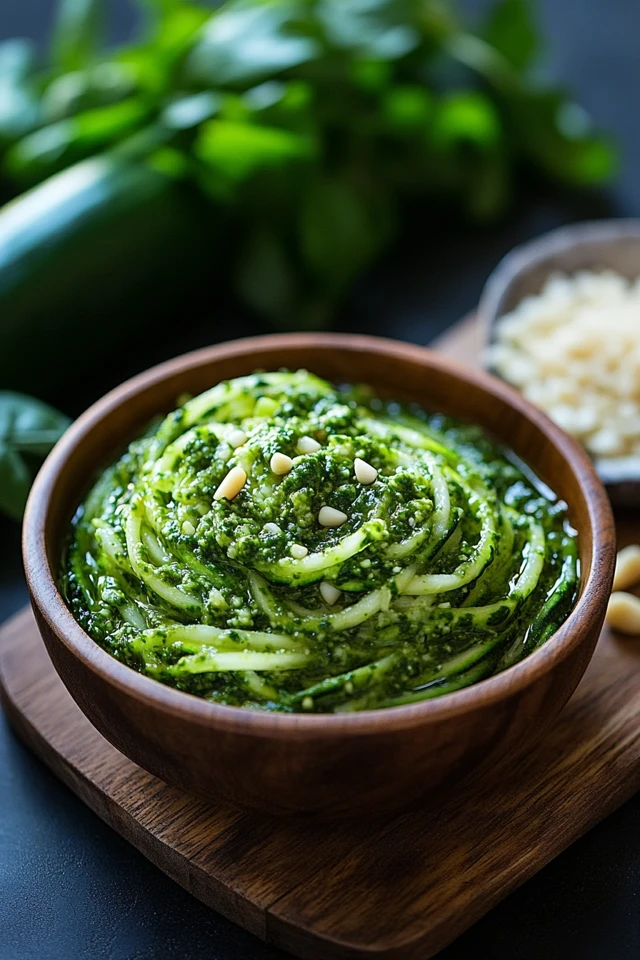
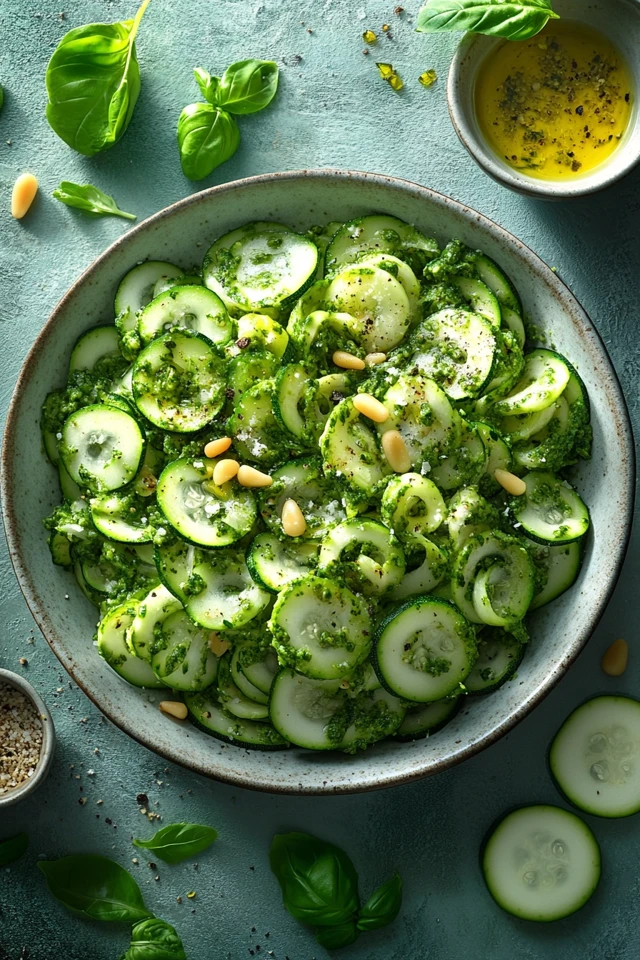
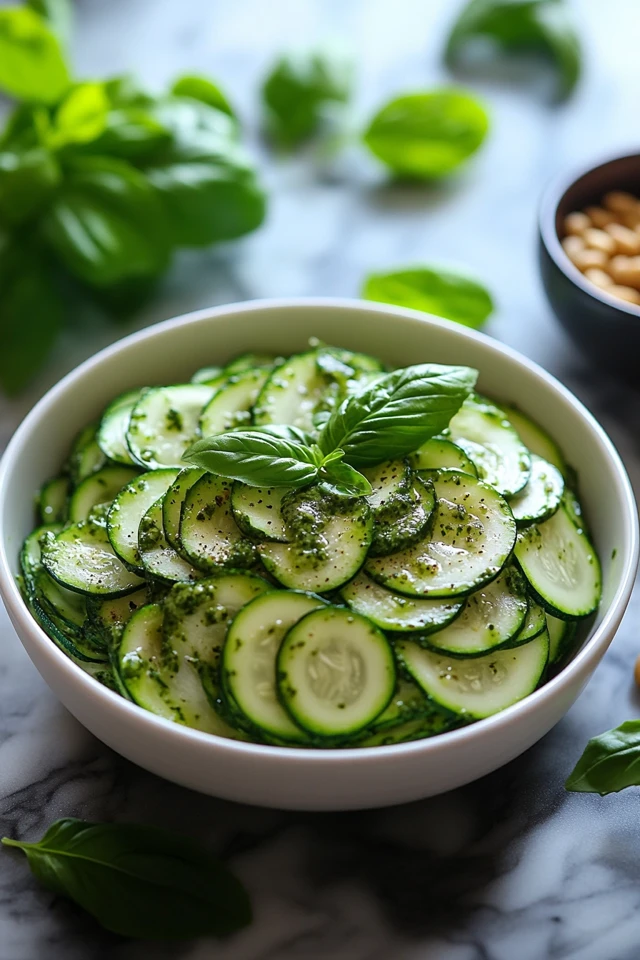
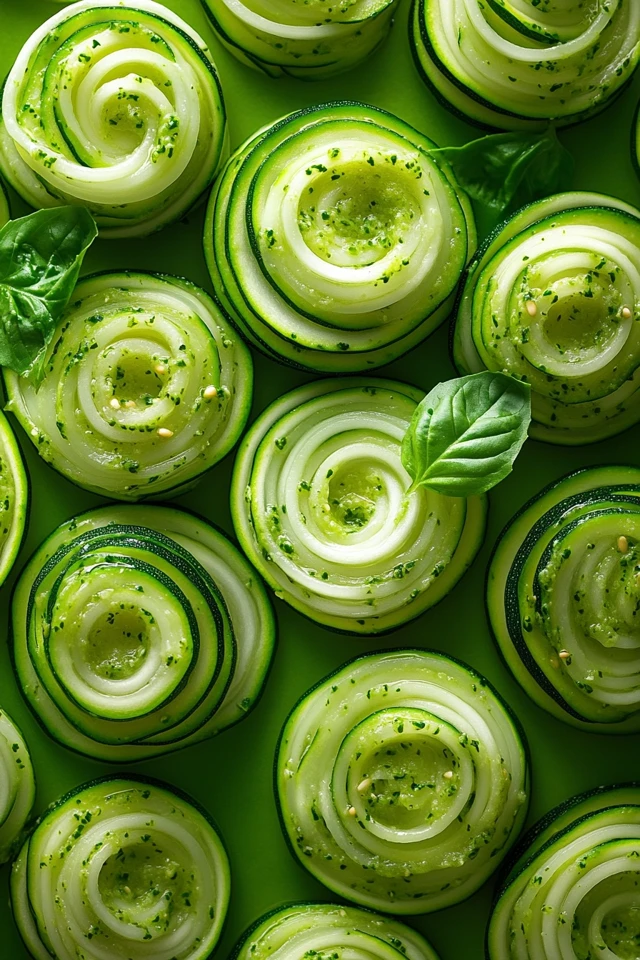
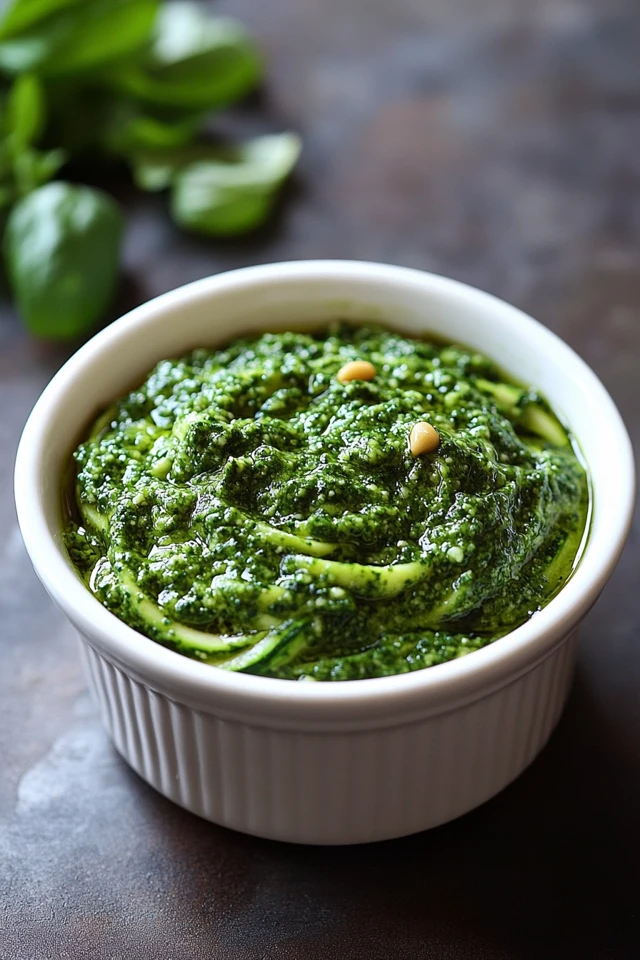
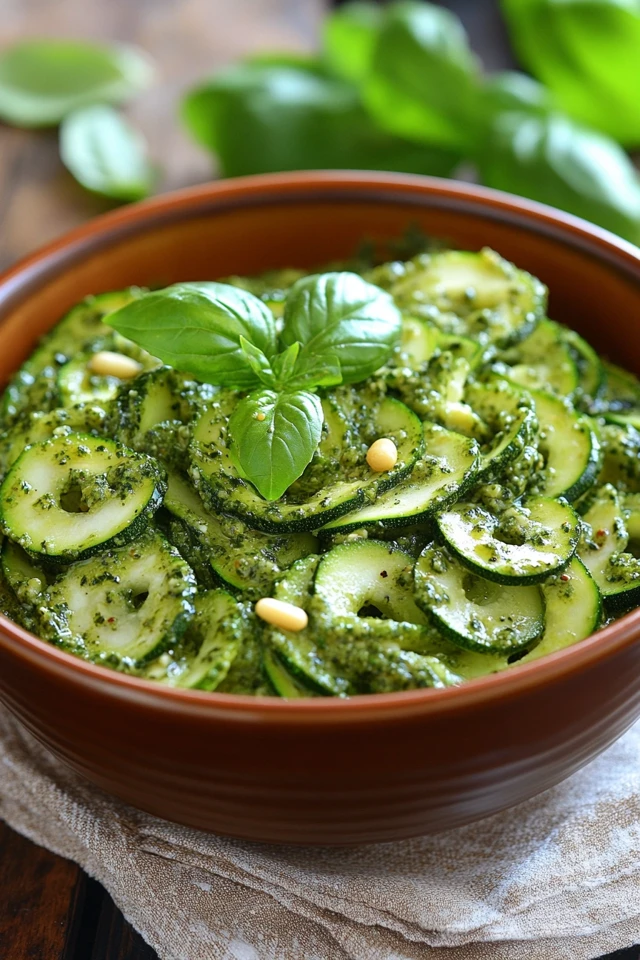
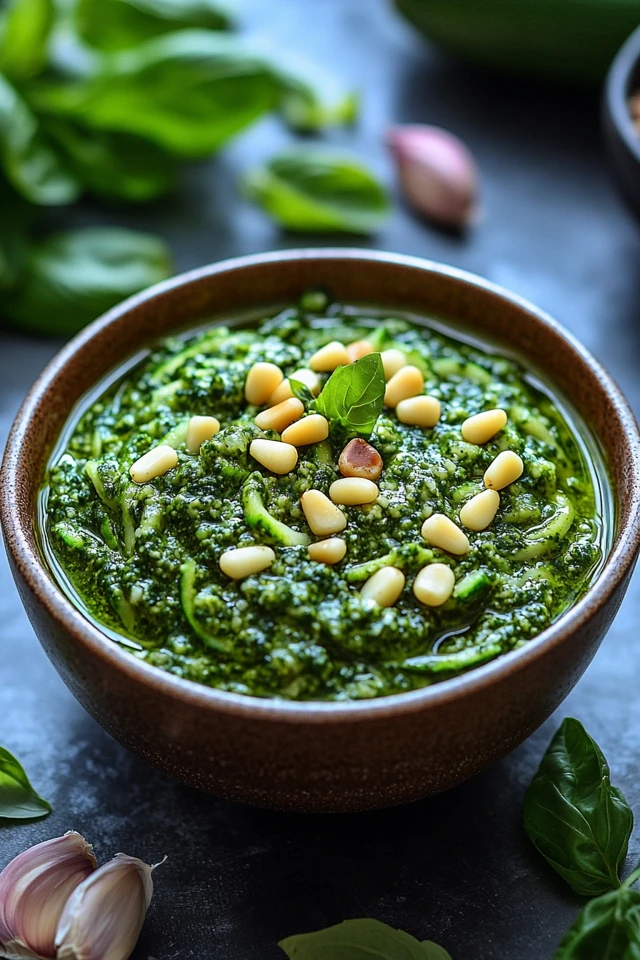
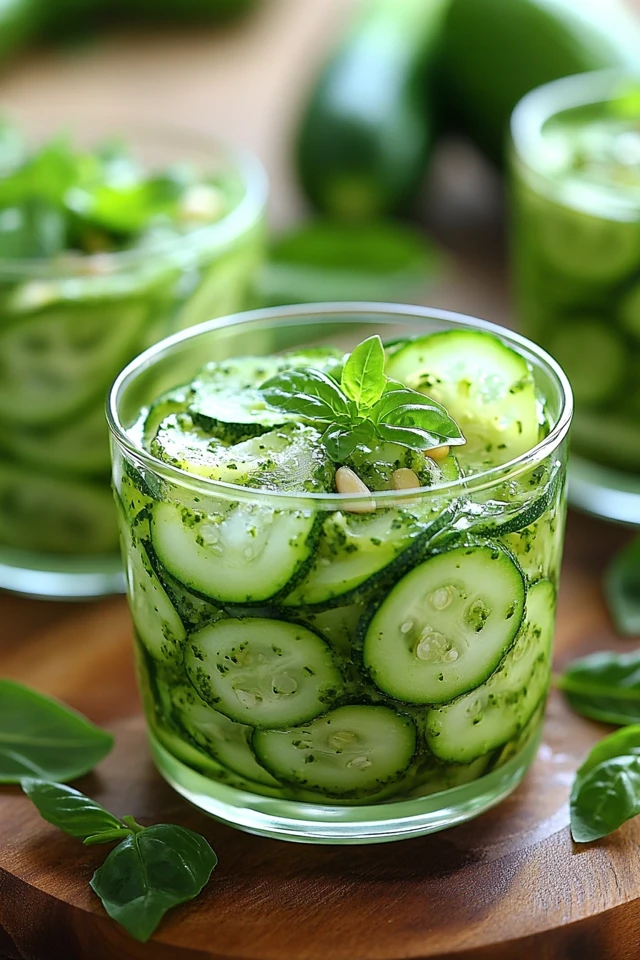
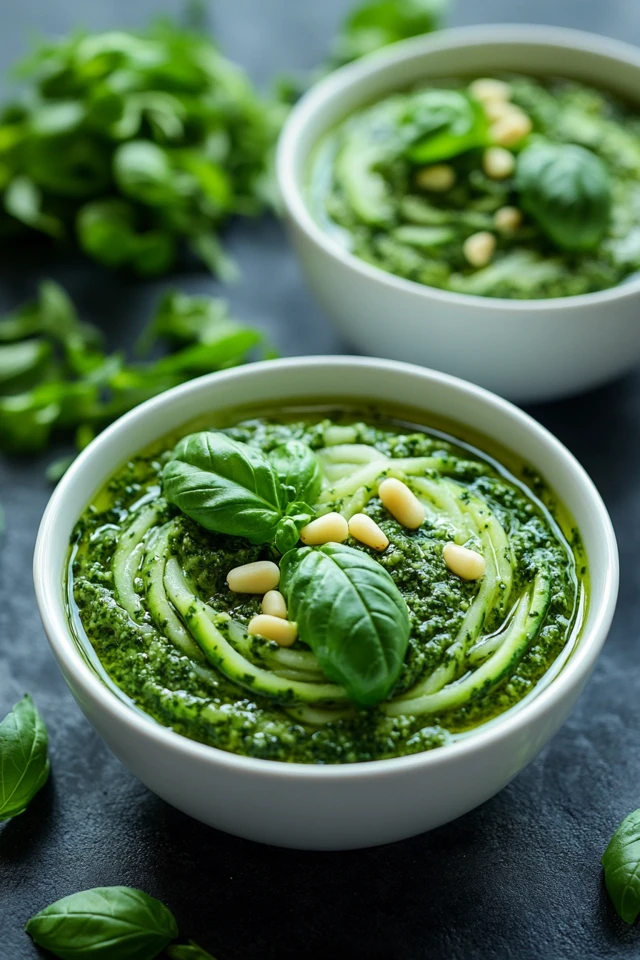
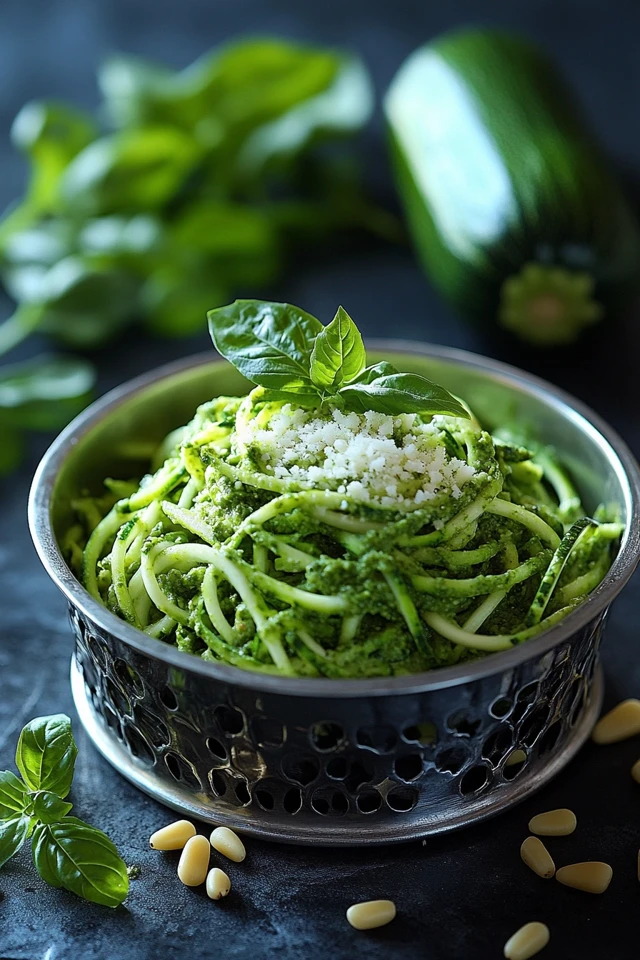
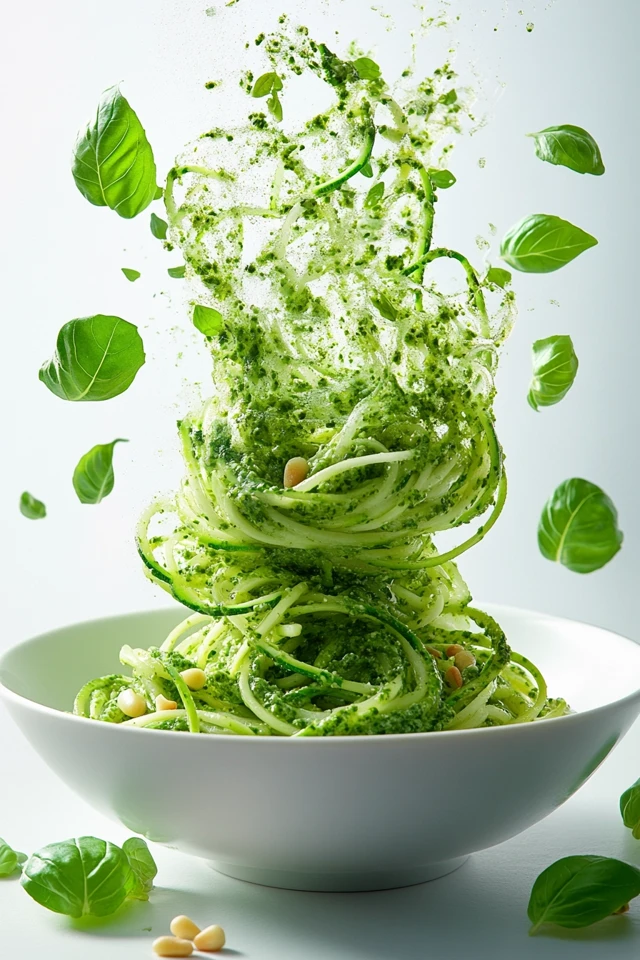
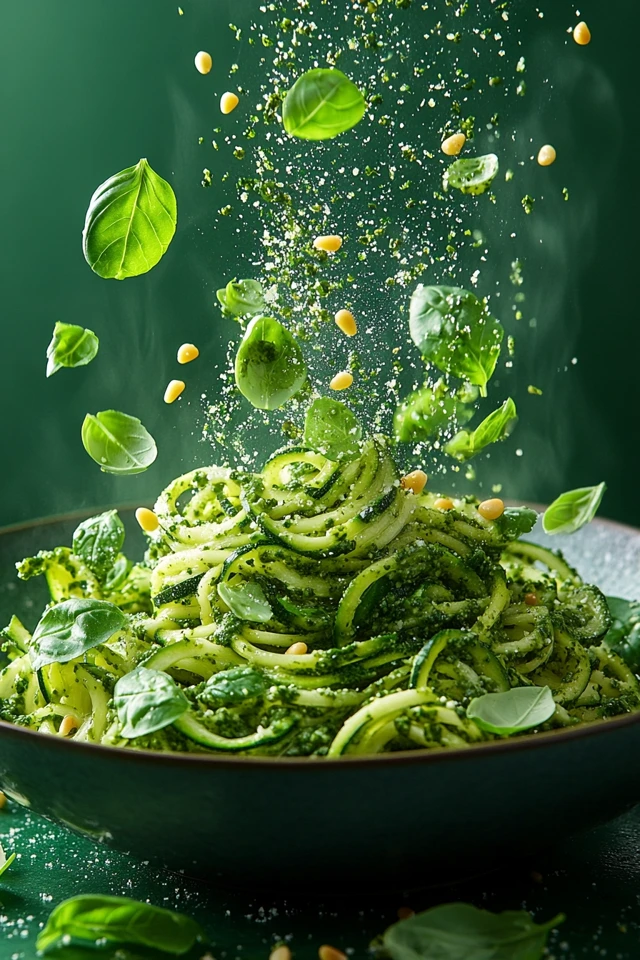
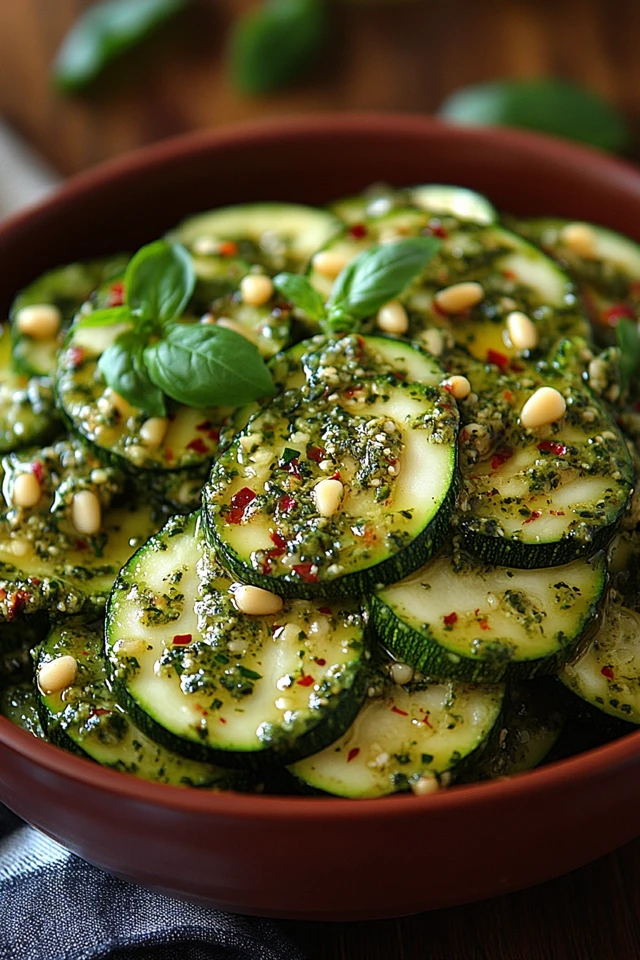
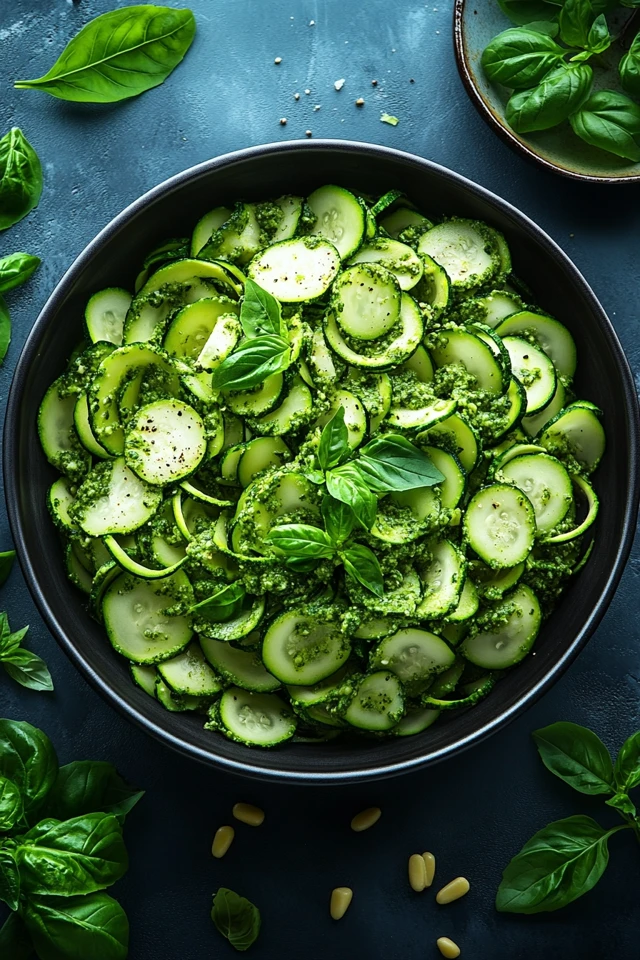
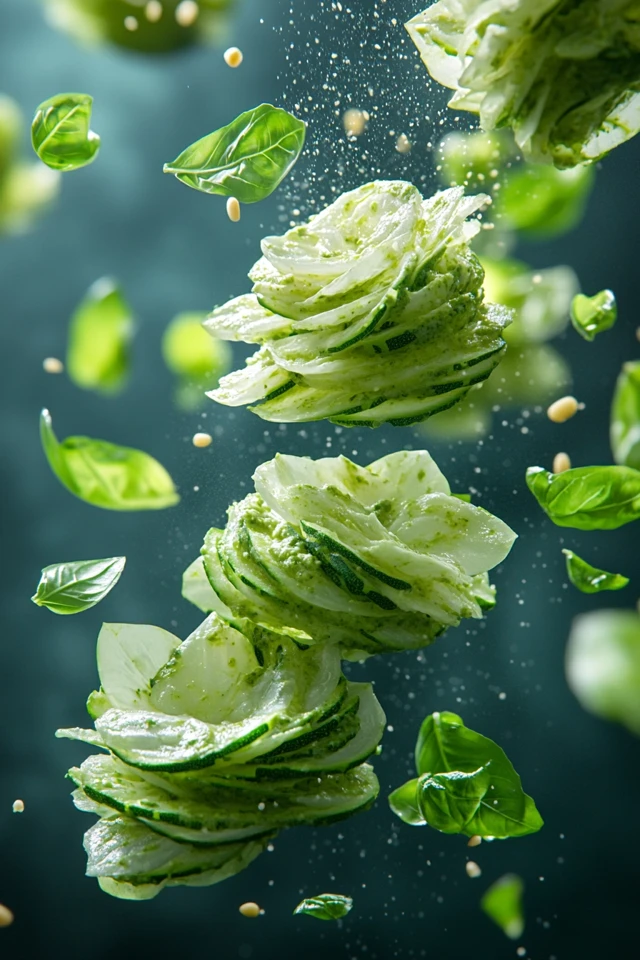
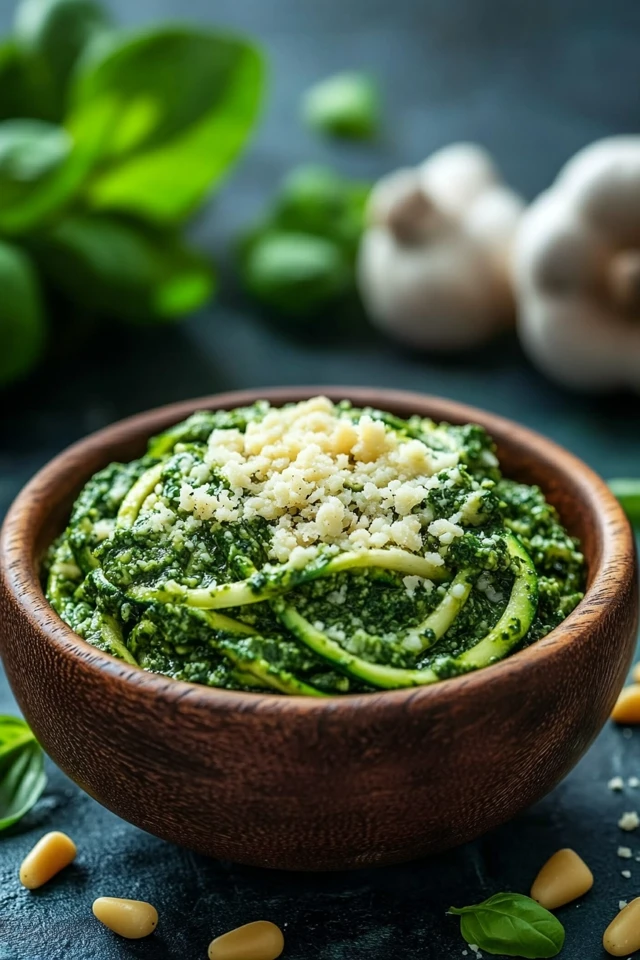
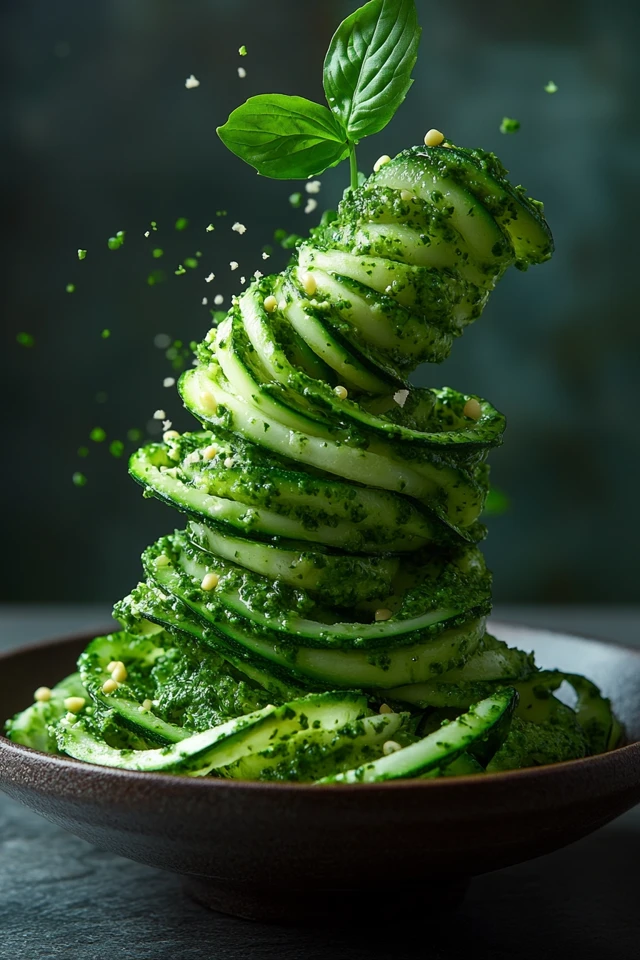
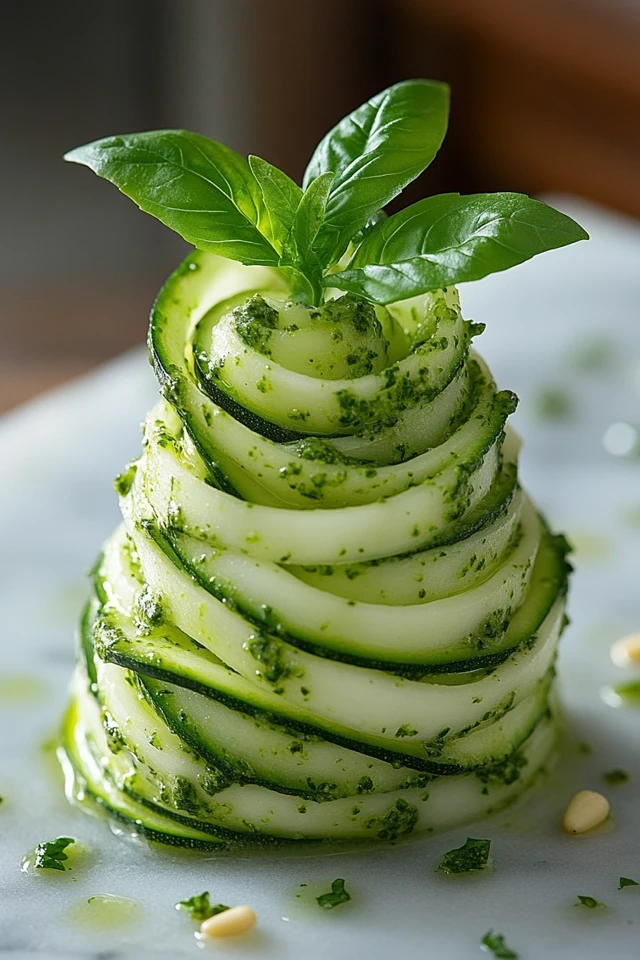
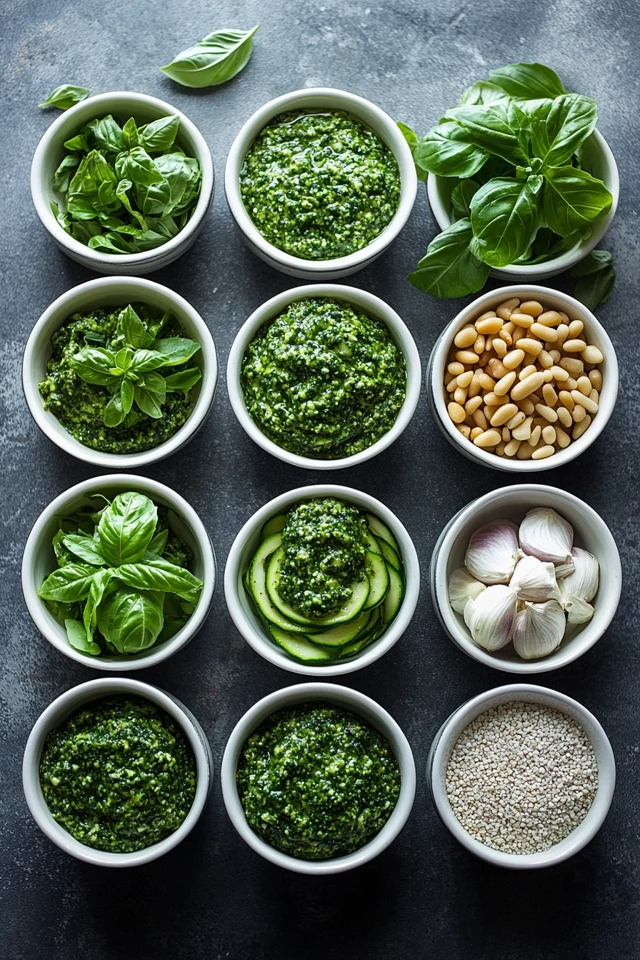
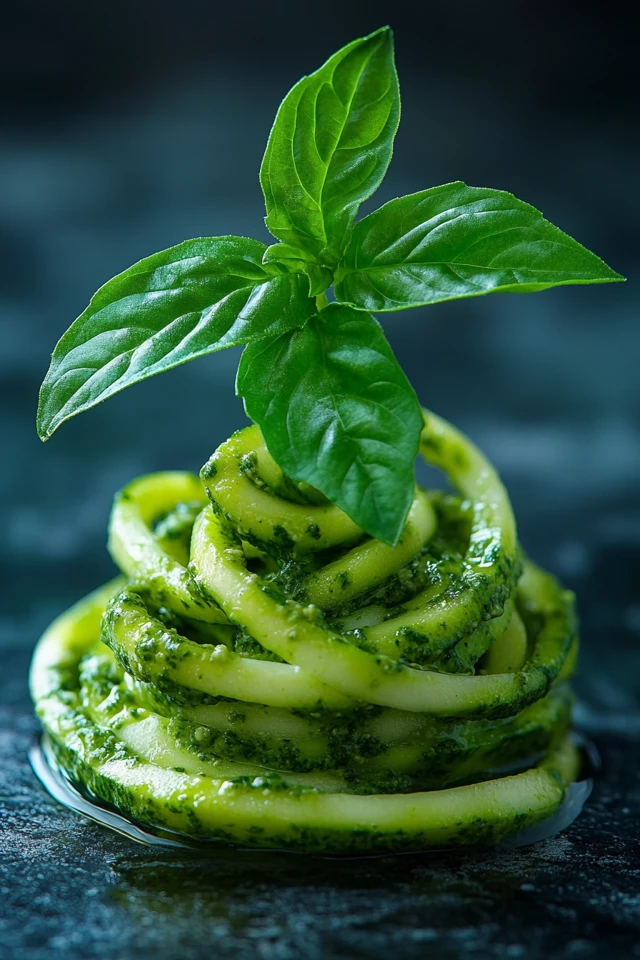
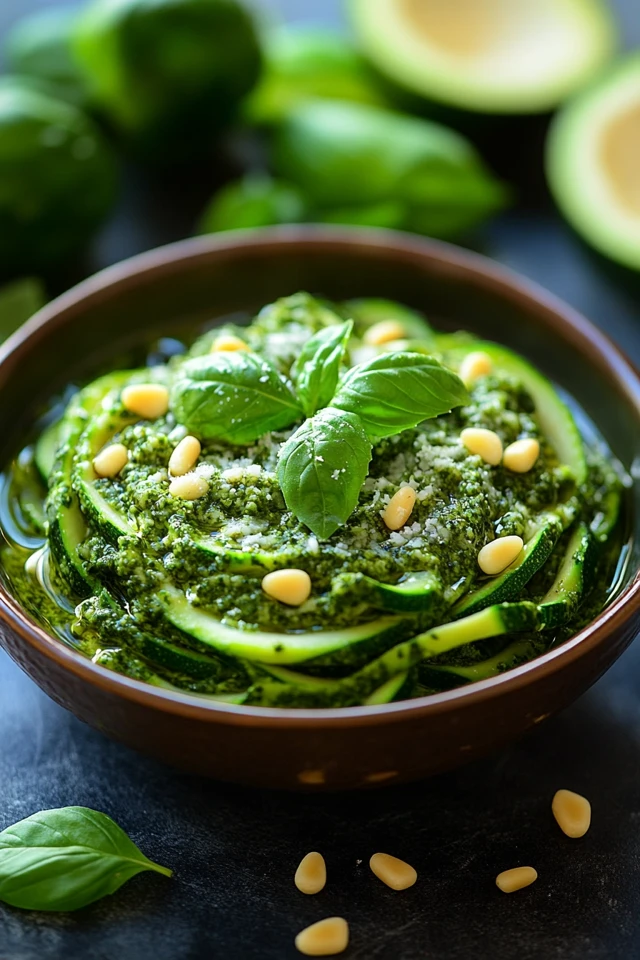
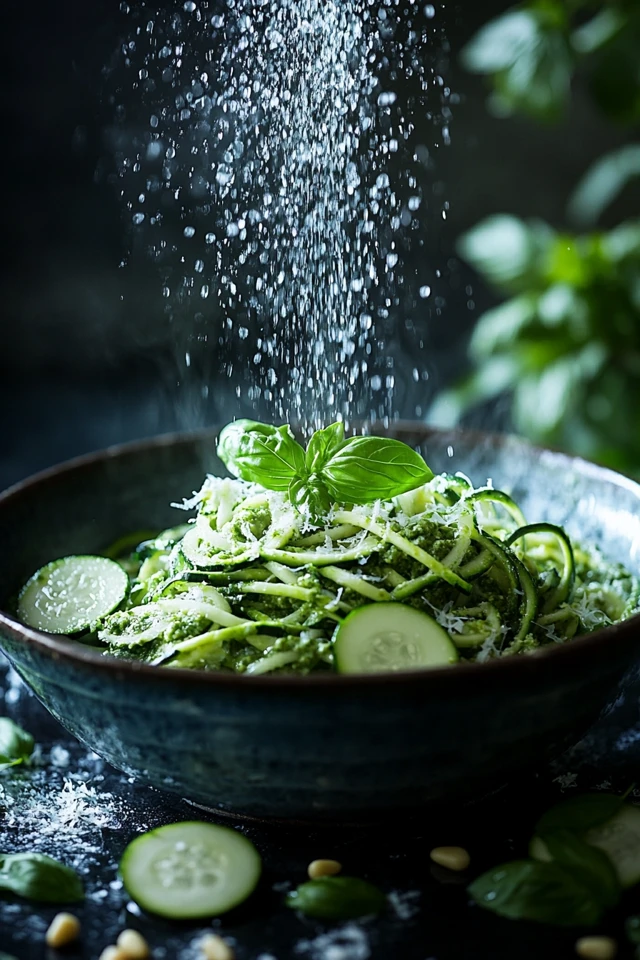
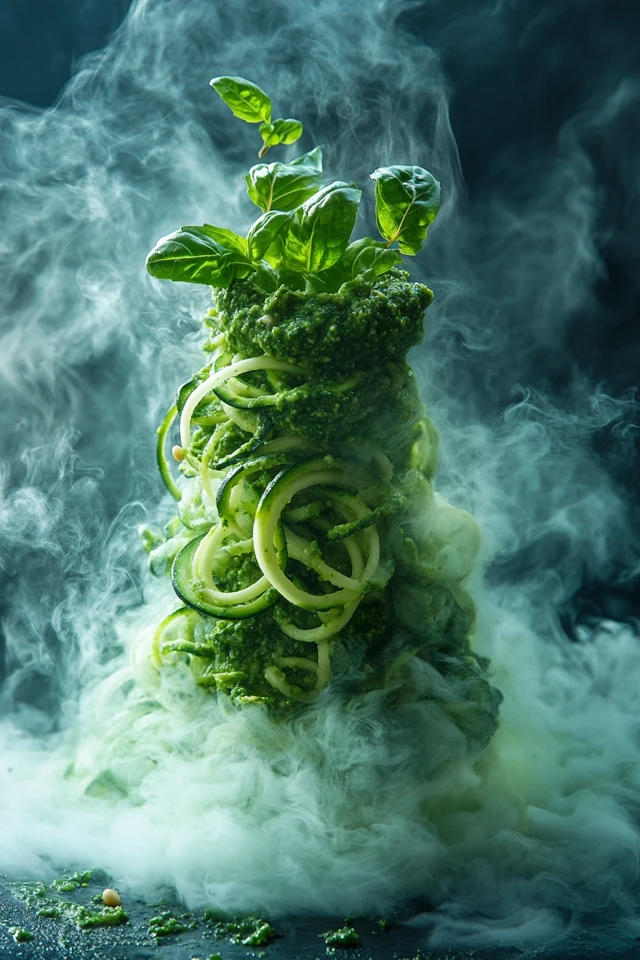
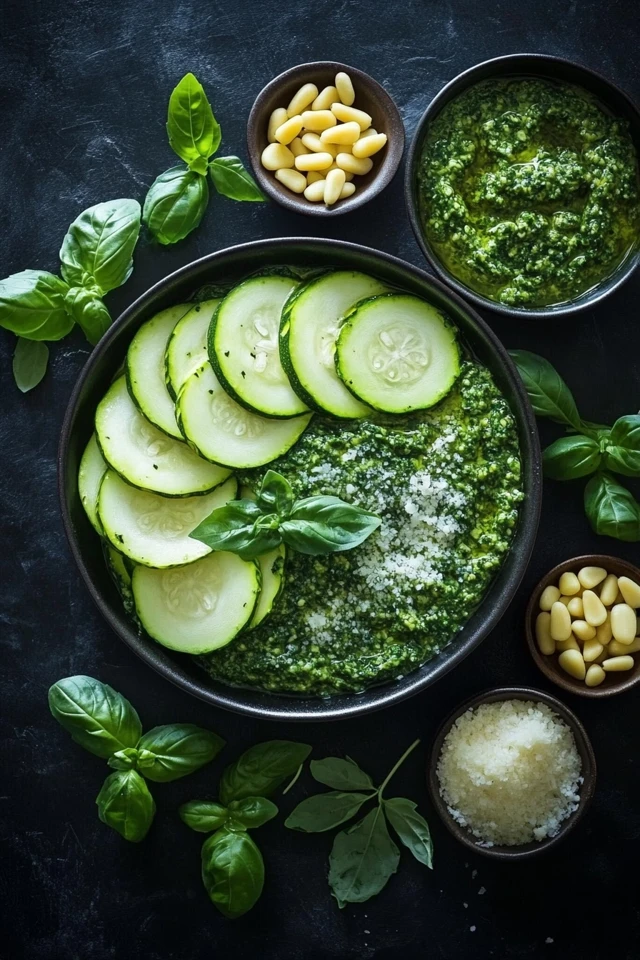
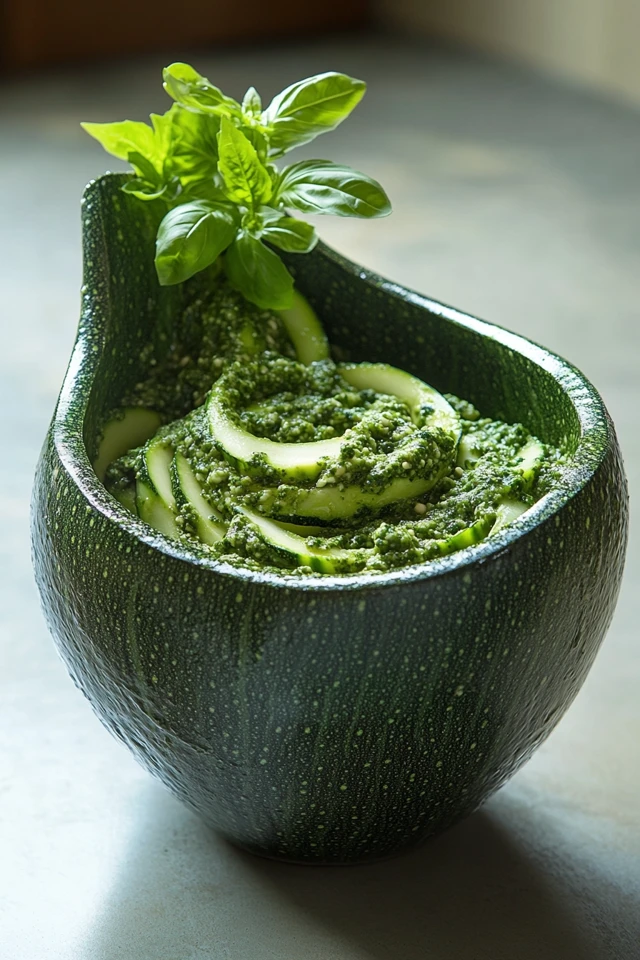
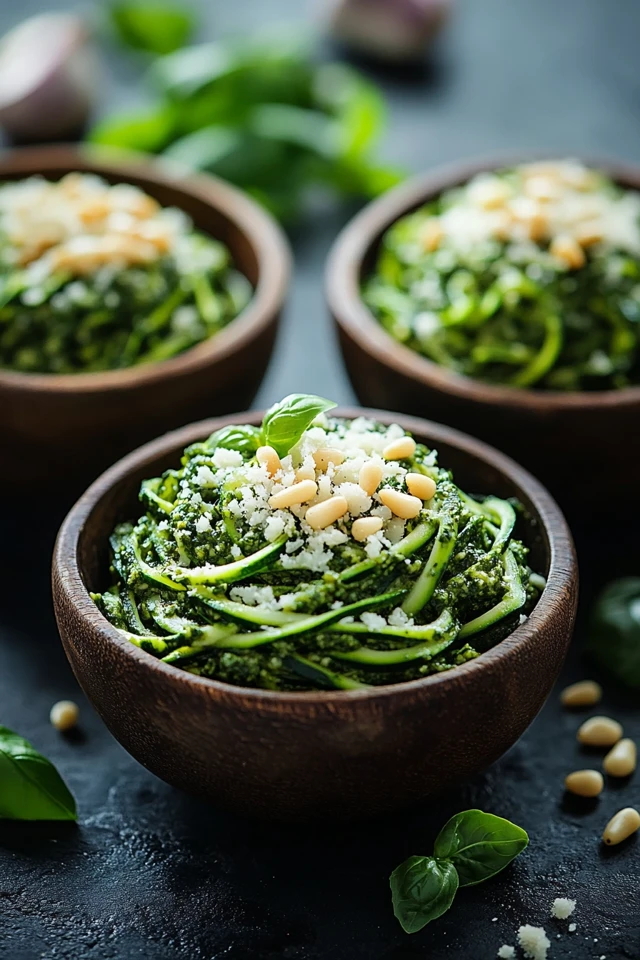
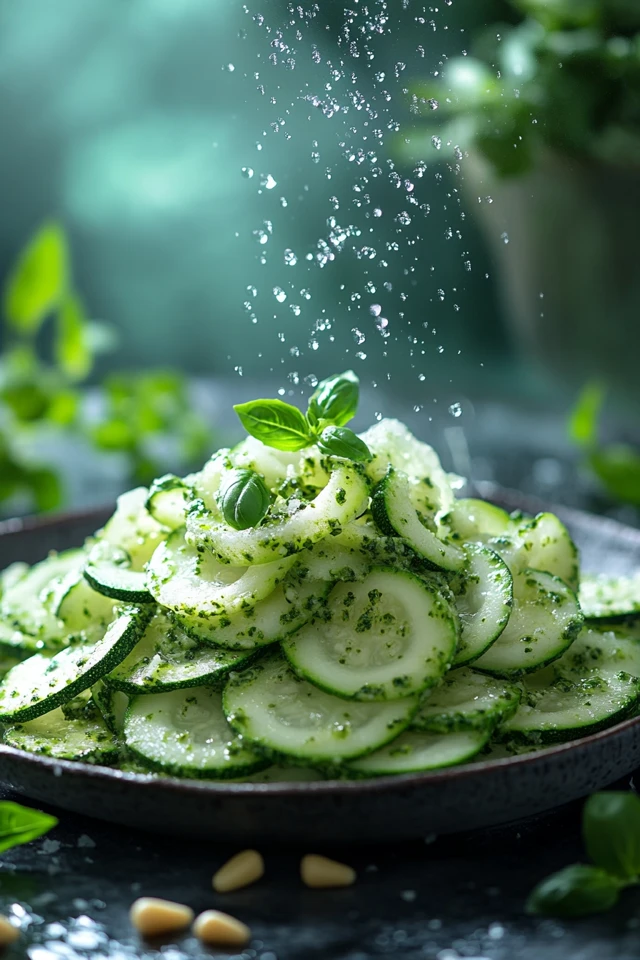
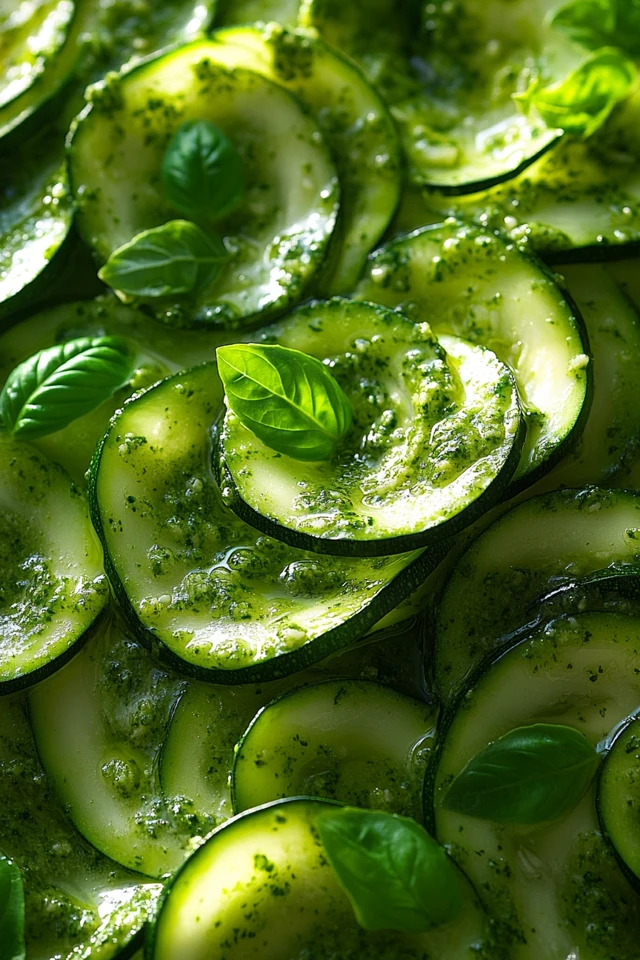
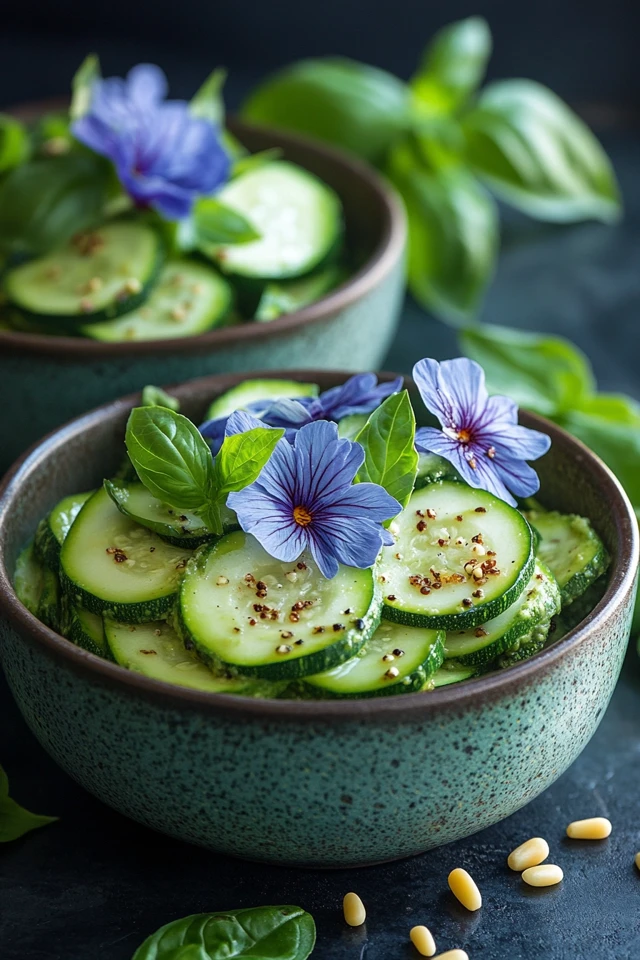
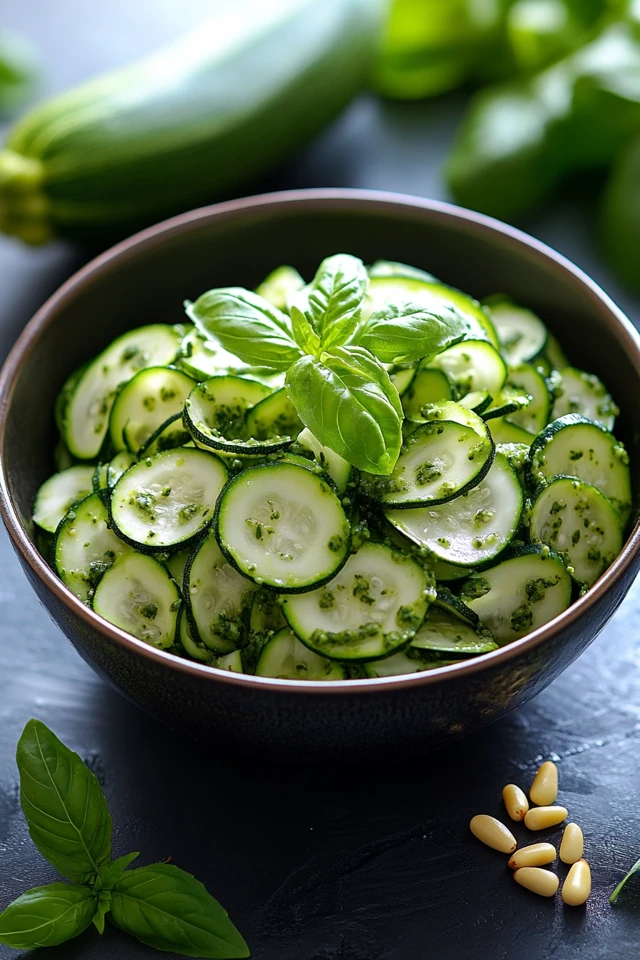
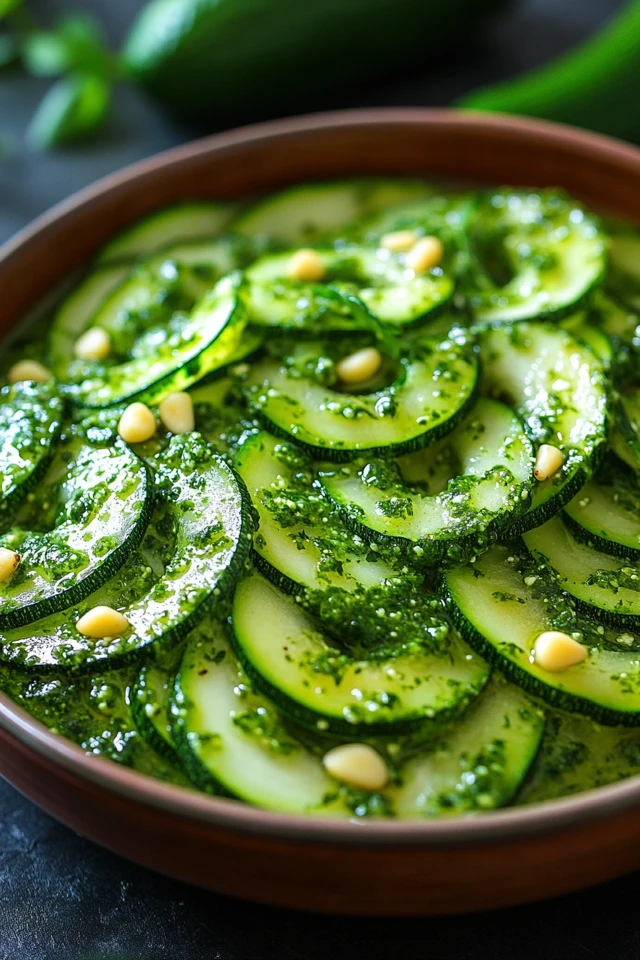
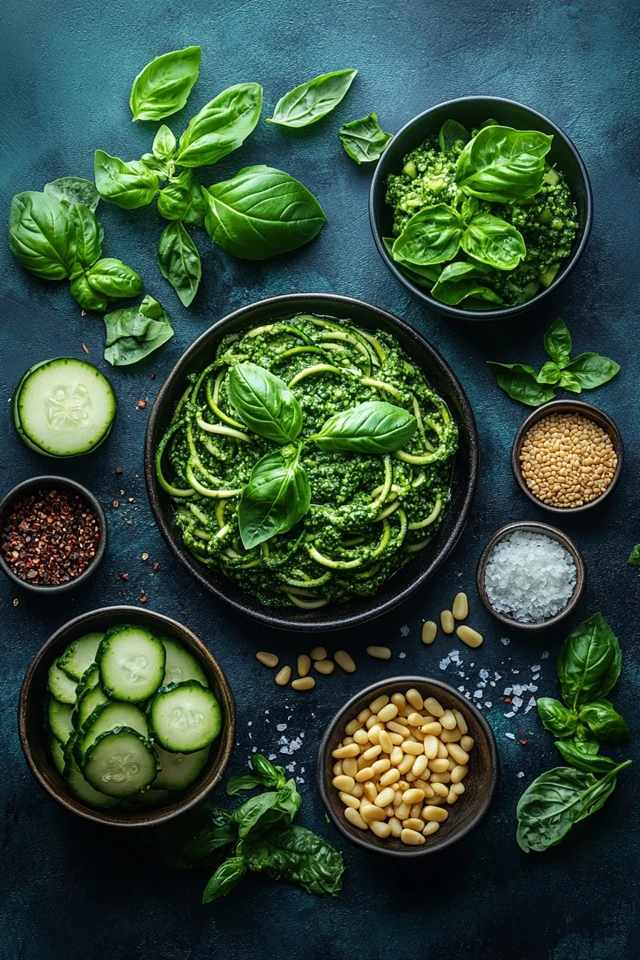
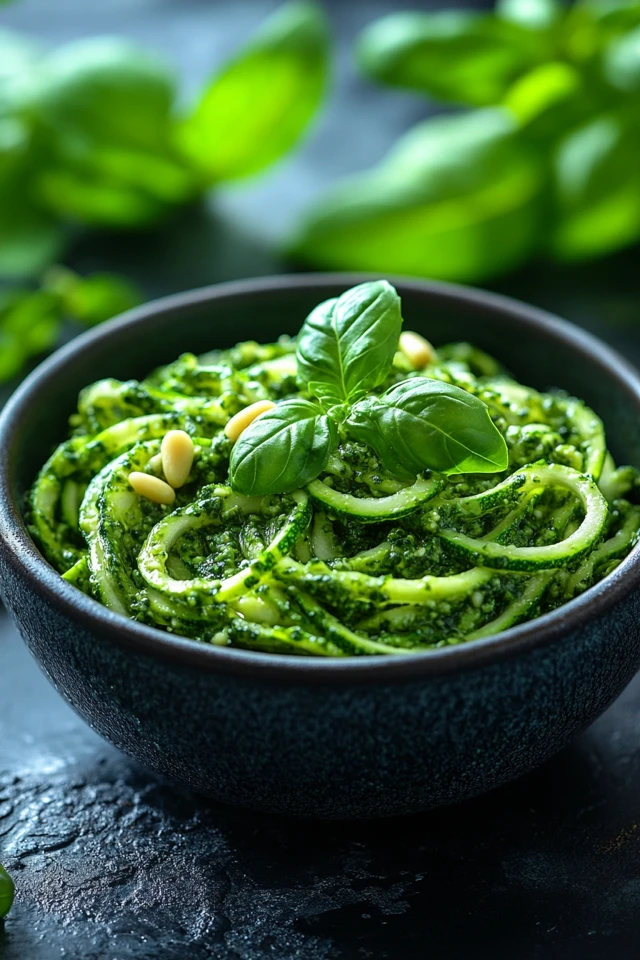
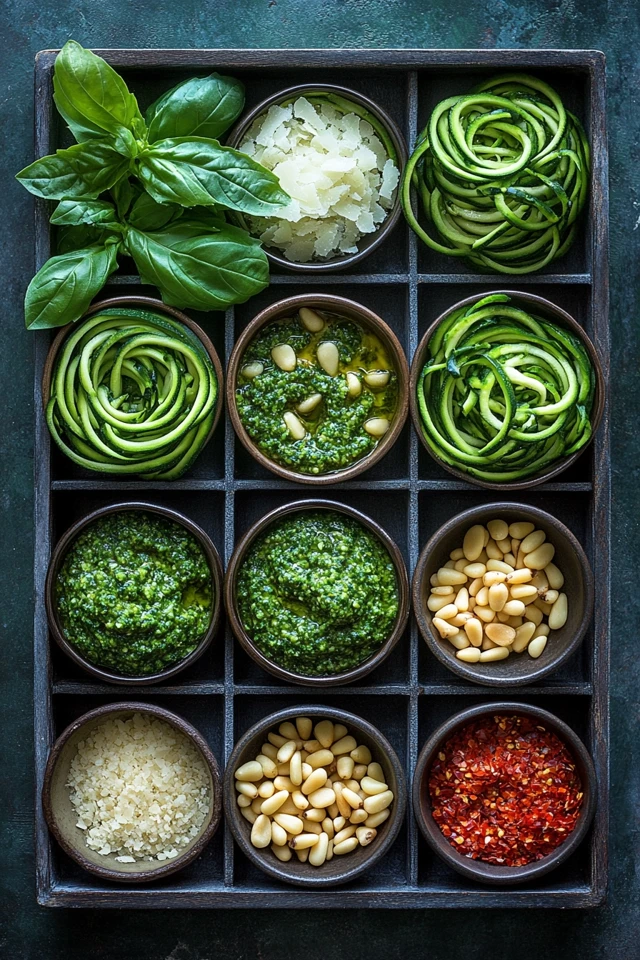
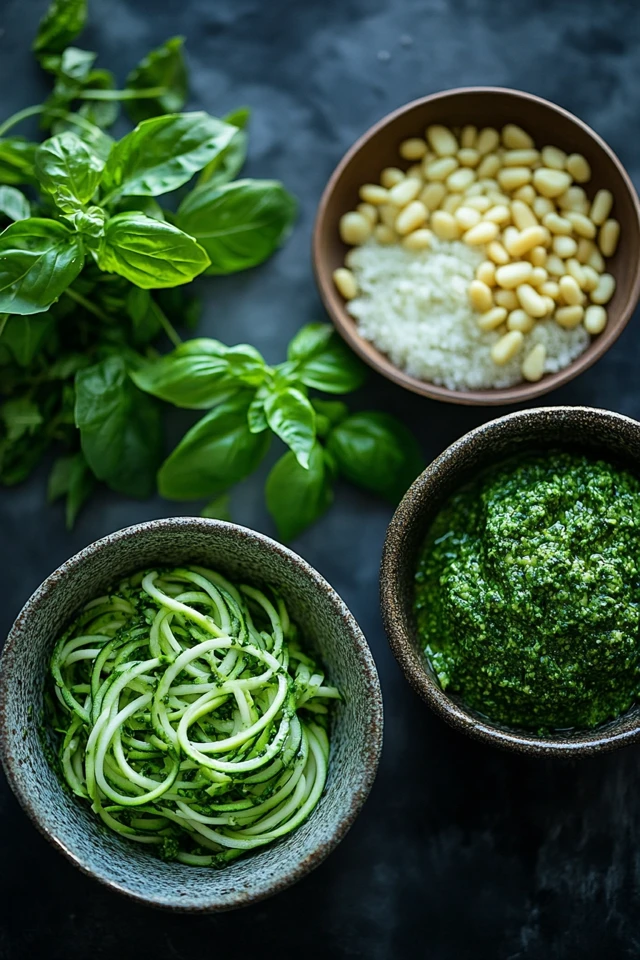
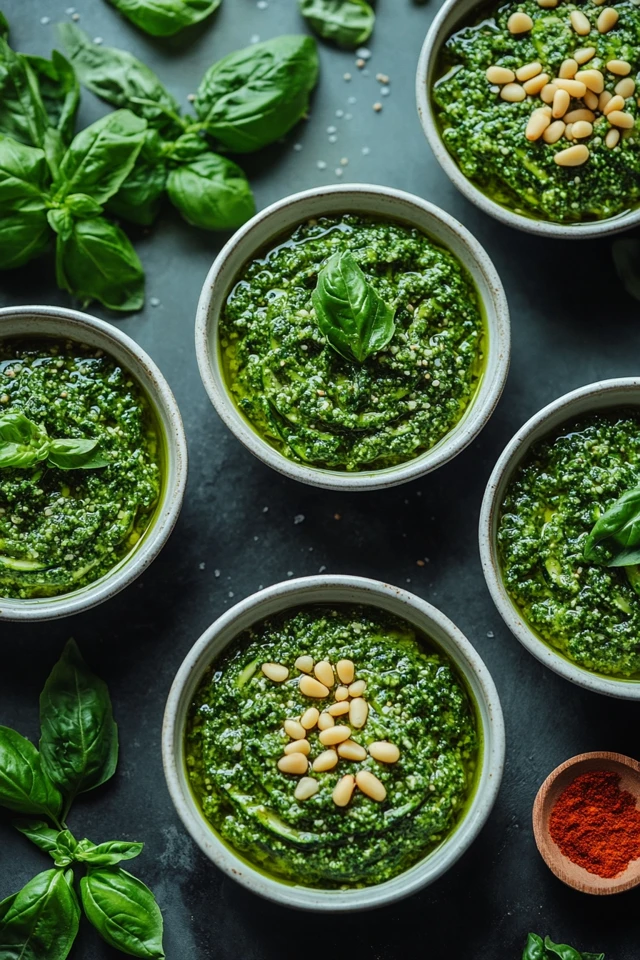
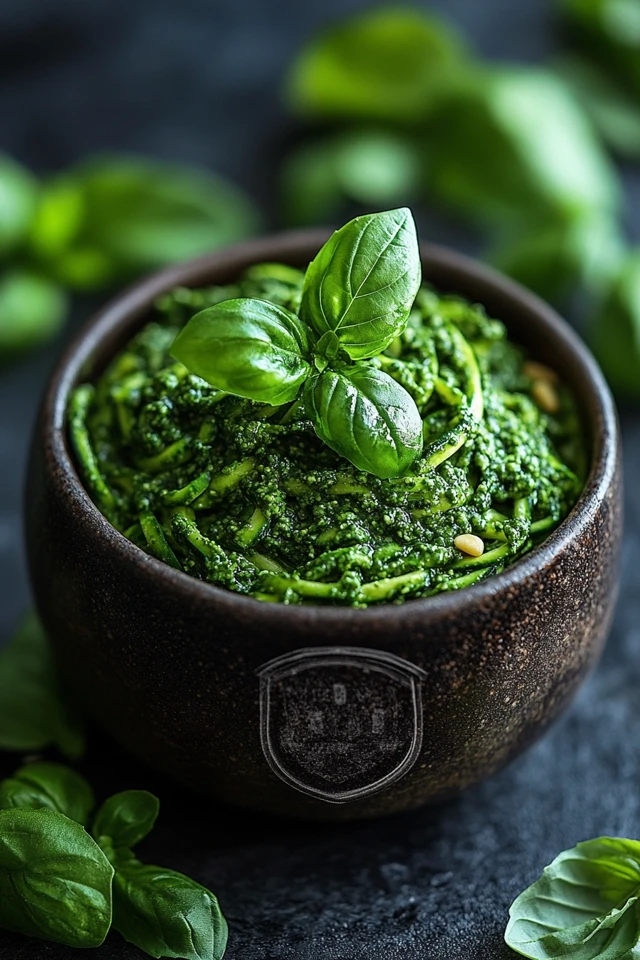
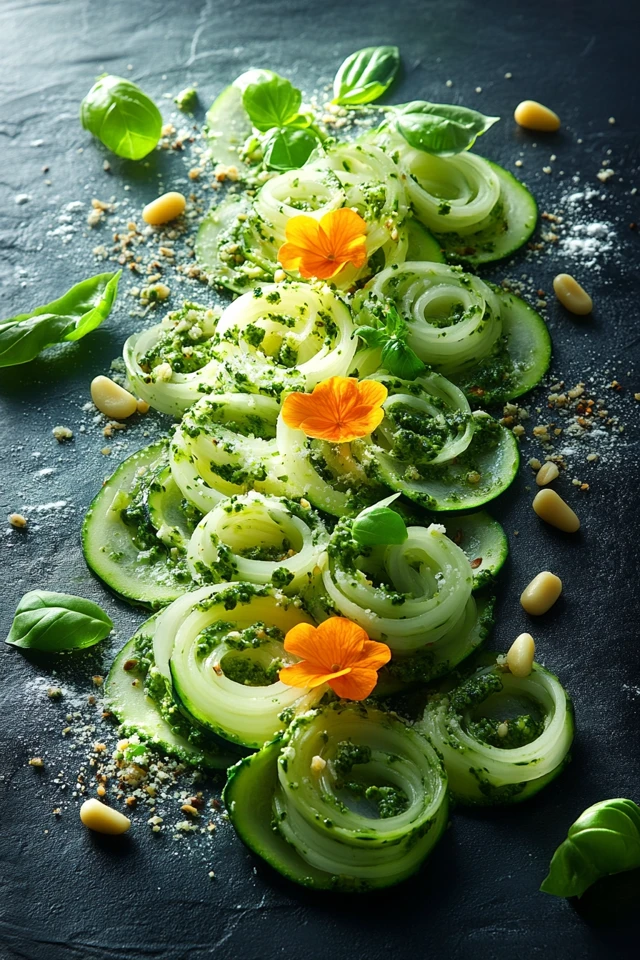
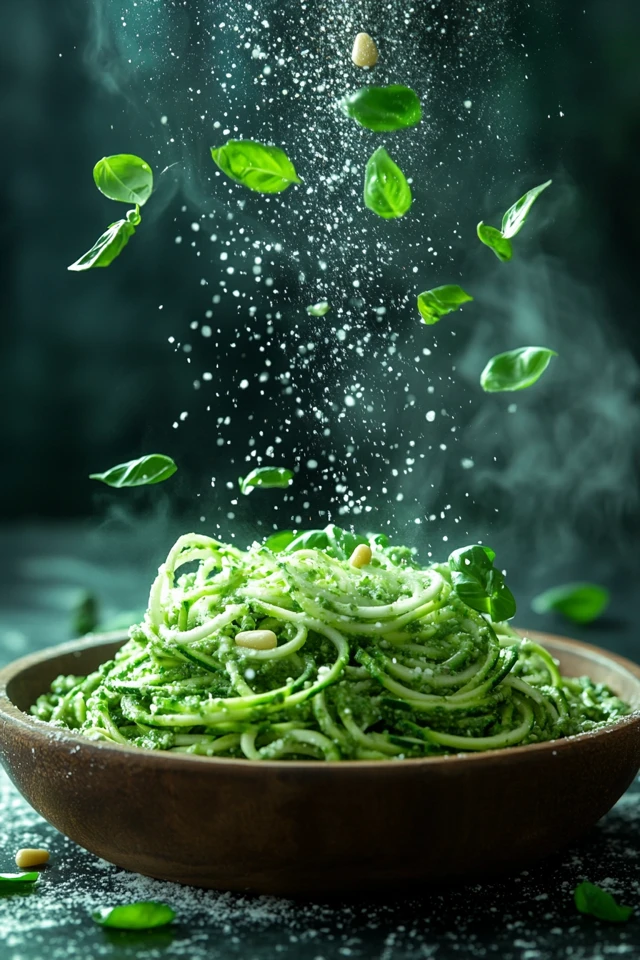
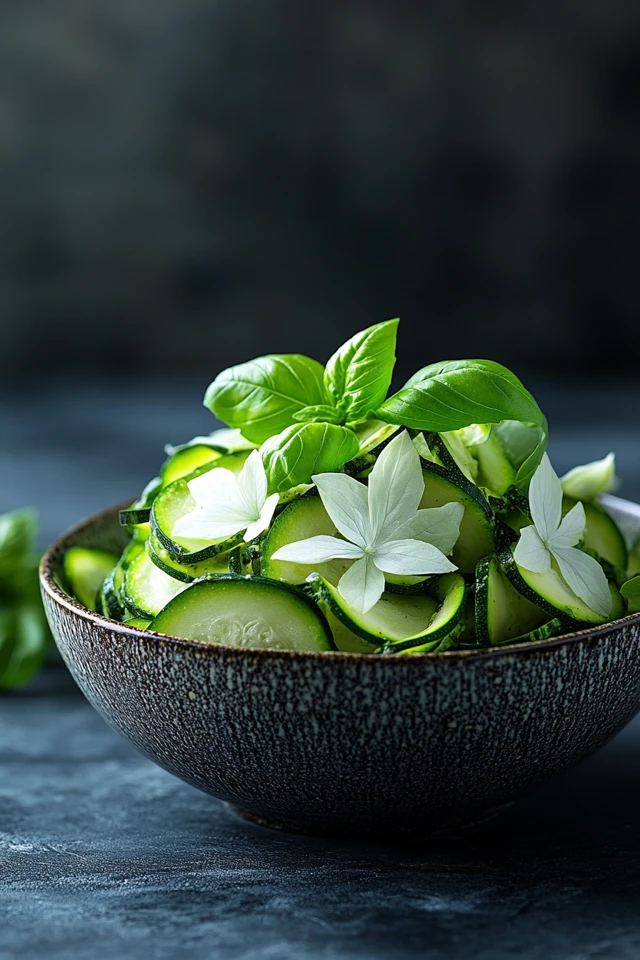
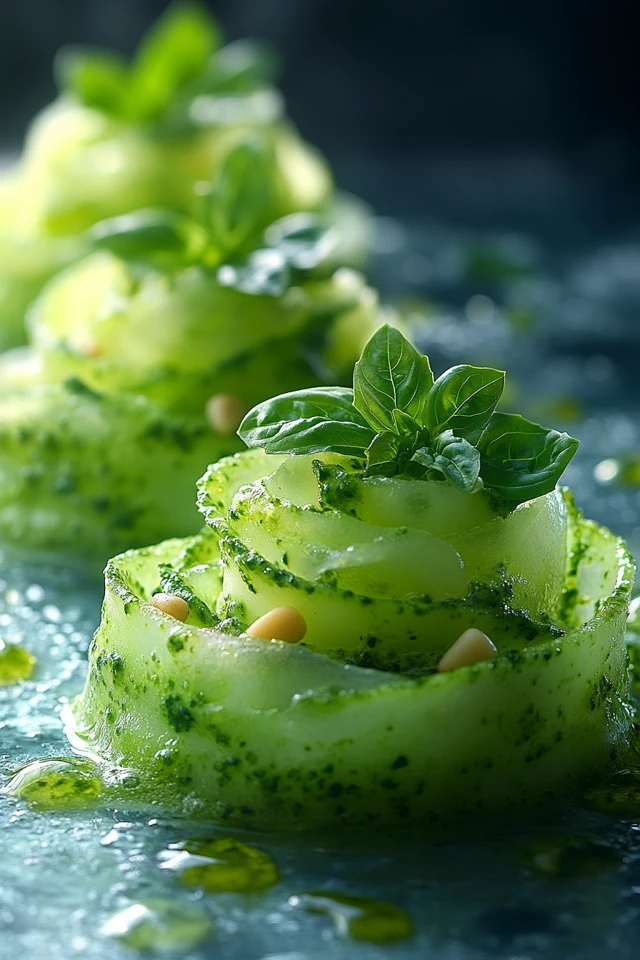
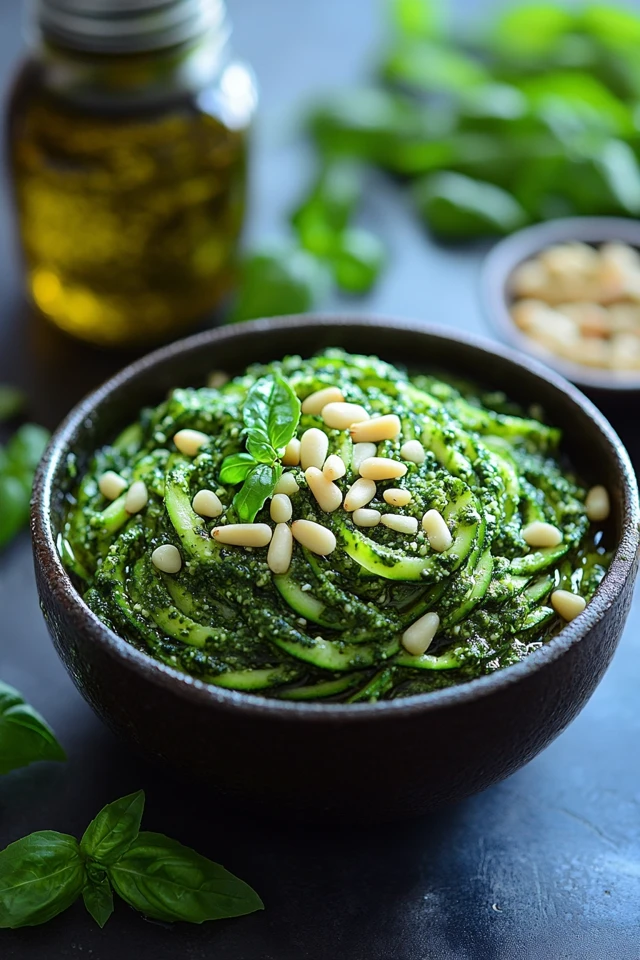
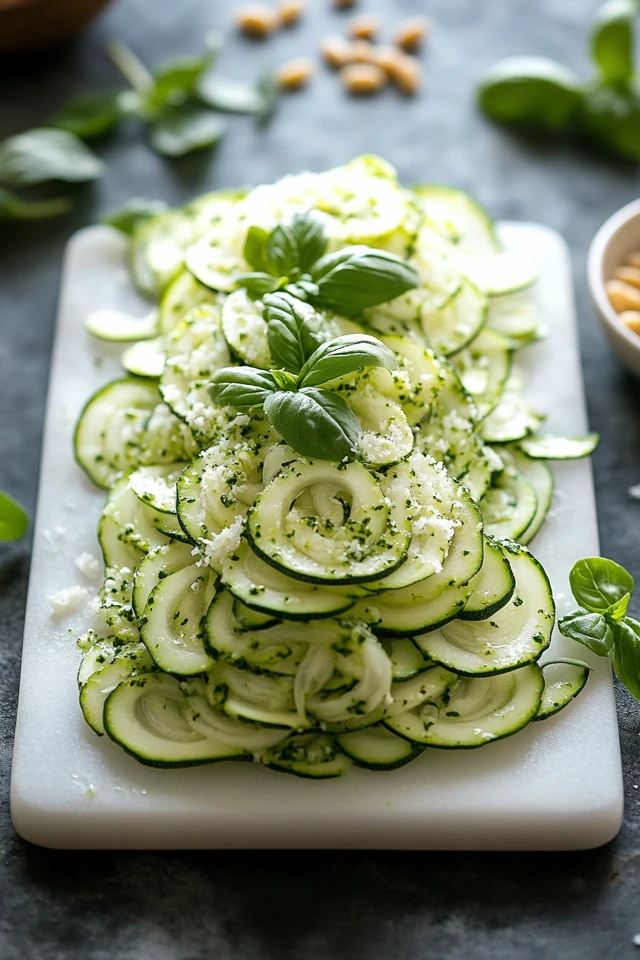
Frequently Asked Questions (FAQs)
1. Can I make the pesto ahead of time?
Absolutely! You can prepare the pesto up to a week in advance. Store it in an airtight container in the refrigerator and cover it with a thin layer of olive oil to prevent oxidation and preserve its vibrant green color.
2. What plant-based milk works best for this recipe?
Oat milk and almond milk are excellent choices for a creamy texture, but soy, coconut, or cashew milk also work well. Choose based on your taste preference and dietary needs.
3. How can I prevent the zucchini noodles from becoming soggy?
To prevent soggy noodles, avoid overcooking them. Sauté the zoodles just until they are tender but still retain some crunch. Additionally, salt the noodles and let them sit for a few minutes before cooking to draw out excess moisture.
4. Can I use different herbs instead of basil in the pesto?
Yes! Feel free to substitute basil with cilantro, parsley, or mint for a unique flavor profile. Each herb brings its own distinct taste, allowing you to customize the pesto to your liking.
5. How do I make the dish vegan?
This recipe is already vegan by default, using plant-based ingredients like vegan yogurt, olive oil, and plant-based milk. Ensure that any additional toppings like vegan cheese or sour cream are also vegan-certified.
6. Can I freeze the pesto?
Yes, pesto can be frozen for up to 3 months. Spoon it into ice cube trays, freeze until solid, then transfer the pesto cubes to a freezer-safe bag or container. Thaw in the refrigerator before use.
7. What can I substitute for pine nuts in the pesto?
If you prefer or need to avoid pine nuts, substitute them with walnuts, almonds, or sunflower seeds. Each nut or seed type will impart a slightly different flavor and texture to the pesto.
8. Can I use store-bought pesto?
Yes, you can use store-bought pesto as a time-saving alternative. Just ensure that it is gluten-free and vegan if you are adhering to those dietary restrictions. Look for brands that specify these certifications on their packaging.
9. How do I spiralize zucchini without a spiralizer?
If you don’t have a spiralizer, you can use a julienne peeler or a mandoline slicer with a julienne attachment to create thin, noodle-like strips from the zucchini. Alternatively, you can use a vegetable peeler to create long, thin ribbons.
10. Can I add other vegetables to the zucchini noodles?
Absolutely! Enhance the nutritional value and flavor by adding other vegetables such as bell peppers, cherry tomatoes, spinach, mushrooms, or roasted butternut squash. These additions can provide extra texture and vibrant colors to your dish.
About the Author
Welcome to Vegan & Plant-Based Kitchen! I’m Julio Arco, a passionate vegan chef dedicated to creating delicious, easy-to-make plant-based recipes that nourish both body and soul. Since embracing a vegan lifestyle in 2010, I’ve been on a culinary journey to explore the endless possibilities of plant-based cooking. From vibrant salads to hearty mains and indulgent desserts, my mission is to inspire and empower you to embrace a compassionate and healthy lifestyle through wholesome food.
Join me on this journey as we explore diverse flavors, experiment with fresh ingredients, and celebrate the beauty of plant-based living. Let’s create, share, and enjoy the goodness of vegan cooking together!
Disclaimer: This blog post is intended for informational purposes only. Always consult with a healthcare professional before making significant changes to your diet.

